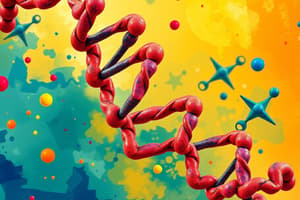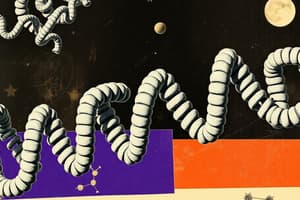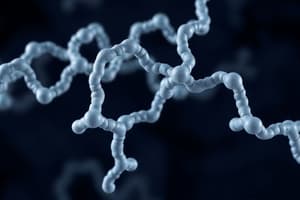Podcast
Questions and Answers
What term is used to describe a chain of 3 amino acids?
What term is used to describe a chain of 3 amino acids?
- Oligopeptide
- Dipeptide
- Tripeptide (correct)
- Polypeptide
Which type of protein is characterized by having multiple polypeptide chains associated noncovalently?
Which type of protein is characterized by having multiple polypeptide chains associated noncovalently?
- Monosubunit proteins
- Simple proteins
- Conjugated proteins
- Multisubunit proteins (correct)
What is the main role of a prosthetic group in a protein?
What is the main role of a prosthetic group in a protein?
- To play an important role in the protein’s biological function (correct)
- To serve as a structural component
- To increase the overall molecular weight of the protein
- To provide additional amino acids
Which classification of proteins is based on physiochemical properties?
Which classification of proteins is based on physiochemical properties?
What defines a protein according to its amino acid count?
What defines a protein according to its amino acid count?
What characterizes amino acids as chiral centers?
What characterizes amino acids as chiral centers?
Which amino acid class would include serine and threonine?
Which amino acid class would include serine and threonine?
Which amino acids have R groups with a net negative charge at pH 7.0?
Which amino acids have R groups with a net negative charge at pH 7.0?
What is the outcome of the polymerization of amino acids?
What is the outcome of the polymerization of amino acids?
Which amino acids are classified as having significantly polar R groups?
Which amino acids are classified as having significantly polar R groups?
What key principle explains how the specific sequence of monomeric subunits affects the function of macromolecules?
What key principle explains how the specific sequence of monomeric subunits affects the function of macromolecules?
Which of the following groups do proteins belong to as macromolecules?
Which of the following groups do proteins belong to as macromolecules?
Which of the following statements regarding amino acids is incorrect?
Which of the following statements regarding amino acids is incorrect?
What type of bond links amino acids together in proteins?
What type of bond links amino acids together in proteins?
Which statement accurately describes the role of water in relation to biomolecules?
Which statement accurately describes the role of water in relation to biomolecules?
Flashcards
Dipeptide
Dipeptide
A molecule composed of two amino acids linked together by a peptide bond.
Tripeptide
Tripeptide
A molecule composed of three amino acids linked together by peptide bonds.
Oligopeptide
Oligopeptide
A chain composed of 3-10 amino acids linked together by peptide bonds.
Polypeptide
Polypeptide
Signup and view all the flashcards
Multisubunit protein
Multisubunit protein
Signup and view all the flashcards
Polymers
Polymers
Signup and view all the flashcards
Protein Structure and Function
Protein Structure and Function
Signup and view all the flashcards
Amino Acid Diversity
Amino Acid Diversity
Signup and view all the flashcards
Peptide Bond
Peptide Bond
Signup and view all the flashcards
Protein Separation and Identification
Protein Separation and Identification
Signup and view all the flashcards
What makes an amino acid chiral?
What makes an amino acid chiral?
Signup and view all the flashcards
What are hydrophobic amino acids?
What are hydrophobic amino acids?
Signup and view all the flashcards
What are hydrophilic amino acids?
What are hydrophilic amino acids?
Signup and view all the flashcards
What is the significance of the R-group in amino acids?
What is the significance of the R-group in amino acids?
Signup and view all the flashcards
What is a zwitterion, and why do amino acids have zwitterionic forms?
What is a zwitterion, and why do amino acids have zwitterionic forms?
Signup and view all the flashcards
Study Notes
Amino Acids, Peptides, and Proteins
- Proteins are composed of amino acids (AA)
- There are 20 standard amino acids
- Additional 2 (selenocysteine and pyrrolysine)
- Amino acids are linked by peptide bonds
- forming linear chains
- Individual proteins differ in their AA sequence
- This sequence determines their chemical and functional properties
- Proteins have many vital functions
- Protein structure is crucial for their function
- Protein structure is determined by their sequence of amino acids
Biomolecules
- Proteins, carbohydrates, lipids, and nucleic acids are vital biomolecules
- These are the fundamental components of all life forms
Polymers
- Most biomolecules are polymers
- Polymers are composed of repeating units called monomers
Protein Structure Principles
- The structure of a macromolecule determines its function
- Non-covalent interactions are vital for protein structure and function
- A specific sequence of monomeric subunits can hold information essential to the ordered biological life states
Water's Influence on Biomolecules
- Water and its ionization products (H+ and OH−) significantly affect the structure, organization, and properties of cellular components, including proteins, nucleic acids, and lipids
- Non-covalent interactions between biomolecules are heavily influenced by water's solvent properties, especially its capacity to form hydrogen bonds with itself and other molecules.
Key Principles of Proteins
- Proteins in all living organisms are built from 20 common amino acids
- The amino acids are linked via peptide bonds to form polypeptide chains of varying lengths
- Individual proteins differ significantly in their AA sequence
- This unique sequence determines their structure and function
Amino Acids
- Amino acids have an amino and carboxylic acid group bonded to the same carbon atom (α-carbon)
- The side chain (R group) differentiates amino acids
- Side chains vary in structure, size, and electrical charge, consequently influencing water solubility
Chiral Centers
- The α-carbon atom is a chiral center
- The four different groups attached to the α-carbon can form two distinct spatial arrangements
- These arrangements are called stereoisomers (enantiomers)
- They interact differently with light
Classification of Amino Acids by R-Groups
- Amino acids are classified into major groups based on properties of their R-groups
- This is helpful in characterizing/grouping amino acids
Nonpolar, Aliphatic R Groups
- Amino acids in this group are nonpolar and hydrophobic (water-insoluble)
- Their side chain's structures contribute to their hydrophobic effects
Aromatic R Groups
- These aromatic (ring-containing) side chains are typically nonpolar and hydrophobic and contribute to the hydrophobic effect
- The hydroxyl group in tyrosine can form hydrogen bonds
- Tyrosine and tryptophan are more polar than phenylalanine
Polar, Uncharged R Groups
- These amino acids have differing degrees of polarity, and their side chains can form hydrogen bonds
- Cysteine is an important outlier due to its sulfur-containing group
Positively Charged (Basic) R Groups
- The amino acids in this group carry a positive charge at neutral pH (7.0) due to an amine group
- Lysine, arginine and histidine are relevant examples of this class
Negatively Charged (Acidic) R Groups
- Aspartate and glutamate are negatively charged amino acids due to their carboxyl group side chains
Non-Standard Amino Acids
- Some amino acids are not common constituents of proteins but play important roles in other biological processes
AA Derivatives
- The body converts some amino acids into important molecules like neurotransmitters or other bioactive compounds
AA; Acids or Bases
- The amino acids' amine and carboxyl groups make them weak acids or bases
- Zwitterions form at neutral pH
Protein Terminology
- Two amino acids bonded are dipeptides, three are tripeptides, 3-10 are oligopeptides, and >10 are polypeptides
Protein Classification
- Simple proteins contain only amino acids
- Compound proteins have additional non-amino acid components (prosthetic groups)
- Derived proteins are products of protein breakdown
- Proteins can be classified by their function (e.g., catalytic enzymes, structural proteins)
Protein Structure Levels
- Primary structure: linear sequence of amino acids
- Secondary structure: local folding patterns, such as α-helices and β-sheets
- Tertiary structure: overall three-dimensional shape of the polypeptide chain; this is the 3-D structure
- Quaternary structure: arrangement of multiple polypeptide chains (subunits); this is the arrangement of multiple 3-D structures
- Non-covalent interactions determine the folded structure
- The structure determines function, and denaturation disrupts this relationship.
Biologically Active Peptides and Polypeptides Occur in a Vast Range of Sizes
- Many proteins have a wide range of sizes
Protein Structure: Tertiary Structure
- Tertiary structure in proteins refers to the overall three-dimensional arrangement of the polypeptide chain or polypeptide subunits.
Protein Structure: Quaternary Structure
- Quaternary structure refers to the arrangement of different polypeptide chains or subunits to form a functional protein/complex
Loss of Protein Structure Results in Loss of Function
- Denaturation causes loss of protein function
- Denaturation can be brought about by different factors like Heat, X-Rays, and Ultrasonic Waves. Specific pH values, salts of heavy metals, Urea, alcohol, and acetone can also cause denaturation
Essential vs. Non-essential Amino Acids
- Some amino acids are essential, meaning the body cannot make them. They must be consumed in the diet
- Other amino acids are nonessential, meaning the body can synthesize them
Protein Intake
- Adequate protein intake is necessary in daily diets.
- Protein intake standards (recommendations) are often dependent on factors including age, gender, activity level, whether pregnant, or consuming a plant-based diet.
Studying That Suits You
Use AI to generate personalized quizzes and flashcards to suit your learning preferences.




